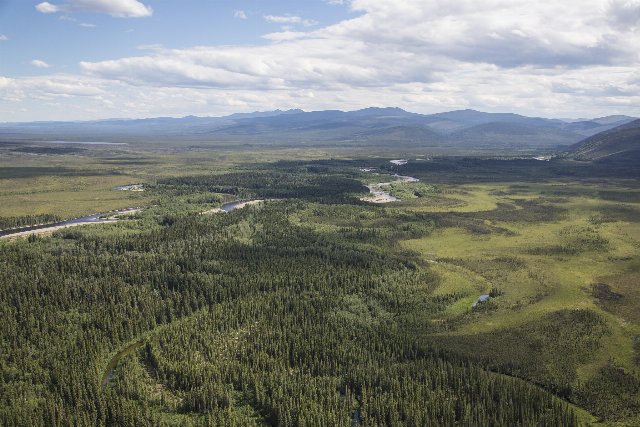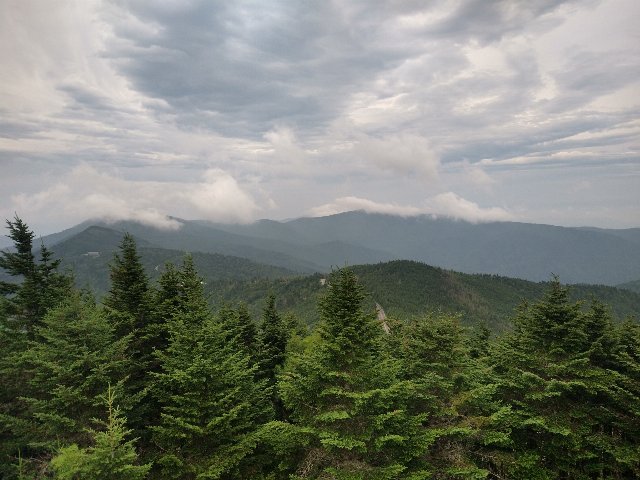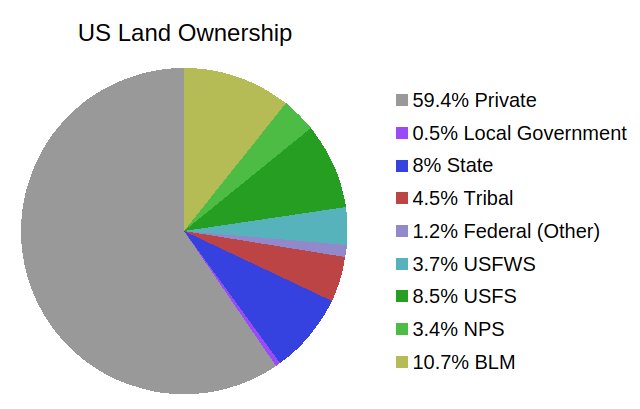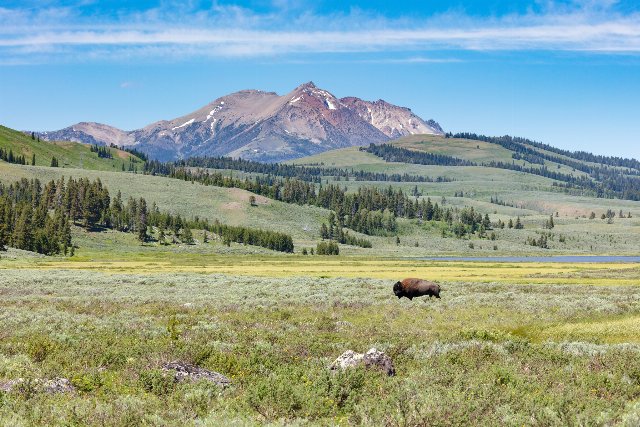The Effect of the 2024 US Election on Plant Biodiversity and bplant.org
October 30th, 2024 by Alex Zorach
bplant.org is an educational and scientific website. Its mission is to facilitate preserving, protecting, and restoring biodiversity, through a focus on wild plants in North America. Although bplant is not focused on politics, our goals are affected by the political system and outcome of elections, especially in the US. Furthermore, our site utilizes many US government resources, many of which will be affected by the election.This blog post outlines both the ways in which the upcoming US presidential election could affect bplant.org, and the ways it could affect plant biodiversity through several different mechanisms: climate change, policies affecting land use, and the general attitude towards science in society as a whole.
Government Resources bplant.org Uses
bplant.org directly utilizes many different government resources. We use the USDA PLANTS database for researching plant ranges, resolving taxonomic issues, assessing wetland status, and in the case of plants with more detailed fact sheets or other data available, informing our habitat sections of articles. The Fire Effects Information System (FEIS) has unparalleled information about the fire ecology of many plants, and also has extensive information on other aspects of plant ecology including habitat, faunal associations, and uses in ecological restoration. Silvics of North America has detailed articles on trees and their ecology.A central aspect of bplant has been our ecoregion-based maps, ecoregion-based plant lists and search, and related tools like the ecoregion locator. We use the US EPA Ecoregion data in the US, and the CEC Ecoregion Data for all of North America. The CEC (Commission for Environmental Cooperation) is a collaborative effort of Canada, Mexico and the United States, working on environmental issues of common concern.
Although we use these government resources heavily, there are numerous others we consult sporadically or use as references for isolated articles or topics. There are also many resources we use, such as websites maintained by public universities at the state level, and research published in peer-reviewed journals, which rely indirectly on federal funding. We also make heavy use of public domain photographs for our ecoregion articles, using photos published by the Bureau of Land Management, National Park System, US Fish and Wildlife Agency, and other federal agencies.
 US government agencies are one of the primary sources for our ecoregion photographs, particularly for remote regions like the Yukon Flats pictured here. One of the great benefits of federal work is that, excepting classified documents, nearly all their publications are in the public domain. This photo is from the Bureau of Land Management (BLM).
US government agencies are one of the primary sources for our ecoregion photographs, particularly for remote regions like the Yukon Flats pictured here. One of the great benefits of federal work is that, excepting classified documents, nearly all their publications are in the public domain. This photo is from the Bureau of Land Management (BLM).There are major policy differences between Harris and the Democrats on one side, and Trump and the Republicans on the other. Across the board, Trump and the Republicans have expressed more hostility towards the Federal Bureaucracy, especially the EPA, showing the intent to cut spending particularly in areas related to science and environmental protection. Furthermore, Trump has proposed to dramatically cut education funding, whereas Harris has pledged to maintain or expand it. Others within the Republican party, including key people in Trump's administration, have outlined a plan called Project 2025 which proposes even more extreme cuts to these federal agencies. It is likely that all or most of the resources we use will suffer to some degree under a Trump presidency, whereas under a Harris presidency they will be more likely to be maintained and/or expanded.
We will be able to achieve more in the work we do under a Harris presidency.
The Effect on Climate Change
Climate change is arguably the single largest threat to biodiversity. Global warming, one component of this change, pushes plant ranges farther north in the northern hemisphere, and to higher elevations. Some populations and species are becoming threatened, whereas others are expanding their ranges. Climate change also affects plants through changes in precipitation, with some areas becoming wetter and others drier, and through an increase in severe weather, including droughts, flooding, and severe wind from hurricanes and/or tornadoes. These changes are already happening. As I write, a huge portion of the US is in a drought, visible on the Drought Monitor (yet another federally-funded resource) and earlier this year, the US was hit by two devastating hurricanes. These other factors also alter where plants can and cannot thrive. Overall, climate change is making conditions more extreme and stressful for plants, as it is for humans. Fraser fir (Abies fraseri) is one of many species threatened by climate change. This species only occurs on "islands" of cool, high-elevation habitats, which will shrink or disappear entirely as the climate warms. This thriving forest of Fraser Fir is at Mt. Mitchell, the highest point in the southern Appalachians; most populations of this species are not as robust as the one here. Photo © Schyler Brown, Public Domain, Source.
Fraser fir (Abies fraseri) is one of many species threatened by climate change. This species only occurs on "islands" of cool, high-elevation habitats, which will shrink or disappear entirely as the climate warms. This thriving forest of Fraser Fir is at Mt. Mitchell, the highest point in the southern Appalachians; most populations of this species are not as robust as the one here. Photo © Schyler Brown, Public Domain, Source.Climate change interacts with other threats such as habitat loss, fragmentation, introduction of invasive species, and other human-induced changes to the environment. Although plants have some ability to adapt to all of these challenges, the pace at which the changes happen is important. The faster and greater the changes, the less plants will be able to adapt, and the more biodiversity will be lost. As such, it is important to minimize the effect of climate change and slow its rate. The slower it occurs, the greater our opportunity to protect and preserve plant biodiversity. In a best-case scenario, we may be able to restore plant populations faster than they are being lost, and help plants to colonize new habitats as their ranges change.
There is a stark difference in the stances on climate change taken by Harris and Trump. Trump rejects the scientific consensus on climate change and has referred to it as a "hoax", and has harshly attacked people who describe climate change as a major threat to future generations. His policies during his first presidency increased fossil fuel use, reversed many regulations aimed to combat climate change, and resulted in the US withdrawing temporarily from the Paris Accords on climate change. Trump also specifically targeted climate-related programs for cuts, in the Department of Energy, the National Oceanic and Atmospheric Administration and the Environmental Protection Agency, although some of these cuts were thankfully blocked by an uncooperative congress.
Harris, on the other hand, not only acknowledges the need to act on the issue of climate change, but has also pushed for greater action. The Democrats have consistently acknowledged climate change as a problem and taken greater measures to address it, whereas only a portion of Republicans have done so, with others either denying or greatly downplaying its effects. Biden immediately reversed the US's withdrawal from the Paris Accords, leaving the US only having withdrawn from it for a total of 107 days. The Biden administration has also undertaken a long list of other actions to fight climate change, from shifting from fossil fuel subsidy to green energy subsidy, to efforts to reduce deforestation and land degradation, reducing transportation emissions, and reducing emissions from agriculture. Harris has expressed a desire to continue and expand these policies.
On this topic of climate change, Harris is clearly the better candidate for protecting plant biodiversity.
The Attitude Towards Science as a Whole
bplant.org is a science-based website, and we advocate a scientific approach as the best way to protect plant biodiversity. The scientific method is the best approach we humans have found to discerning truth, establishing facts, and where possible, beginning to understand cause-and-effect and build theories about how the world works. Science is important both for deciding what to set as our policy goals, and for evaluating which policies would be most effective at attaining those goals.Harris and Trump have adopted different attitudes towards science. Especially during the COVID pandemic, Trump undermined government scientists by publicly contradicting them, and behind-the-scenes he also suppressed and censored them. This problem extends beyond policy into culture, creating a deep-seated public mistrust in science. An Editorial in Scientific American writes: "anti-intellectualism threatens evidence-based policymaking by motivating dangerous opposition to scientific consensus on important issues related to public health, climate change and the economy", and an editorial in Nature argues that Trump "Damaged Science" as a whole. Harris on the other hand has voiced consistent support for science, and Harris even comes from a more scientific background, as her mother, Shyamala Gopalan, was a biomedical scientist.
 This medal represents the Nobel Prize, widely seen as among the most prestigious prizes in the world. The scientific categories of prizes are Chemistry, Physics, Physiology or Medicine, and Economics. Public Domain Photo by Christopher Drexel, Source.
This medal represents the Nobel Prize, widely seen as among the most prestigious prizes in the world. The scientific categories of prizes are Chemistry, Physics, Physiology or Medicine, and Economics. Public Domain Photo by Christopher Drexel, Source.There is a strong consensus among scientists, particularly among the most recognized of them, that Harris is the better choice. 82 American Nobel Prize Winning Scientists have endorsed Harris; these people's prizes span the fields of physics, chemistry, medicine and economics. Scientific American has endorsed Harris, in their second-ever presidential endorsement. This endorsement was defended by editorials in Chemical & Engineering News (C&EN) and the American Council on Science and Health (ACSH). Nature, one of the most prestigious peer-reviewed scientific journals in the world, also published an editorial favoring Harris. It is unusual for popular-science outlets such as bplant.org or Scientific American to make political endorsements, and perhaps even more unusual for peer-reviewed journals like Science and Nature or scientific trade publications like C&EN or ACSH to enter into this dialogue, but the stakes here are high.
Harris is the better choice for restoring and maintaining trust in science.
Policies Affecting Land Use
One of the most important things for protecting plant biodiversity is the preservation of wild habitats in which plants are able to reproduce naturally. Wild areas can exist on both public and private land, and public land in the US can be owned at various levels, including federal, state, county, and local levels. This chart shows that Federal lands (BLM = Bureau of Land Management, NPS = National Park Service, USFS = US Forest Service, USFWS = US Fish & Wildlife Service) make up 27.5% of all land in the US. You can find more detailed data at the USGS Gap Analysis Project or an interactive, more accessible summary at this page published by Headwaters Economics. Photo © , CC BY-SA 4.0.
This chart shows that Federal lands (BLM = Bureau of Land Management, NPS = National Park Service, USFS = US Forest Service, USFWS = US Fish & Wildlife Service) make up 27.5% of all land in the US. You can find more detailed data at the USGS Gap Analysis Project or an interactive, more accessible summary at this page published by Headwaters Economics. Photo © , CC BY-SA 4.0.Public (government-owned) land constitutes 40% of the total land in the US, and Federally-owned land makes up a whopping 27.5% of the total land. Furthermore, the public federal land consists mostly of wild areas, whereas the private lands are much more likely to be developed, either for urban, suburban, or industrial use, or agriculture. As such, federally-owned lands contain the largest areas of wild plant habitat. However, it is not just the area that is important, but its quality. Private land tends to be held on small lots. Not only is private land more likely to be fragmented by a dense road network, but the land use itself is spotty as each land owner may make different management choices. Federal lands house the largest unbroken pieces of habitat and as such have greater ecological value than suggested by their area alone.
 Federal lands are important not just for their total extent of land, but for providing large, contiguous expanses of wild habitats, minimally broken up by roads and development. Here a bull bison wanders across Swan Lake Flat at Yellowstone National Park, one of the most iconic of the US public lands. Photo © Yellowstone National Park, Public Domain, Source.
Federal lands are important not just for their total extent of land, but for providing large, contiguous expanses of wild habitats, minimally broken up by roads and development. Here a bull bison wanders across Swan Lake Flat at Yellowstone National Park, one of the most iconic of the US public lands. Photo © Yellowstone National Park, Public Domain, Source.Trump made numerous changes to public lands, many of which were highly damaging to ecosystems. The National Parks Conservation Association writes: "President Trump and the officials he appointed systematically undermined, degraded and outright attacked the laws that protect our public lands, the agencies that manage them..." and has an 8-page long list of specific actions and commentary on the effects they had, which include selling off public land, weakening environmental protections, and allowing more commercial exploitation. Yale Environment 360 wrote about how many of these changes were hard to reverse, but that the Biden administration has tried to undo as much of this damage as possible. They clarify that 125 of the rule changes had the effect of favoring special interests on public lands; a lot of them involve oil and gas leases, which are hard to reverse and also contribute to climate change.
Harris has pledged to more-or-less pursue similar policies to the Biden Administration, doing her best to protect public land, whereas Trump is likely to do more of what he did during his first administration, leading to loss of public land and degradation of the habitats on it.
Harris is the better choice for protecting wild habitats on public lands.
A Note on Third Parties
You may have noticed that so far, this article has only mentioned two candidates for the presidency. For better or for worse, the US has a two-party system, with a few caveats. There is no other candidate besides Harris and Trump who has a realistic chance of winning, so a vote for a third party can, at best, serve only as a symbolic "protest vote". Because the president is elected through the electoral college, the effect of voting for a third-party candidate is different in a "swing" state where the election is expected to be close, vs. in a state where it is virtually guaranteed that one party wins. In a swing state, a vote for a third party is effectively sitting out, so in a case where there is a major difference between the two mainstream candidates, it is important to vote for the better of the two.In swing states, a vote for a third-party candidate risks throwing the election in favor of the worse candidate.
In Summary
It is with great frustration that I write this post. In an ideal world, trust in science, and commitment to combat climate change and protect wild habitats and the biodiversity that depends on them, would not be political issues. There would be a broad consensus on these goals, and the political process could center on a healthy and respectful debate about the best and most effective ways to achieve them. And popular science outlets like bplant.org could largely stay out of the political discussion, perhaps only stepping in occasionally to comment on specific policy proposals.But this is not the world we live in. The upcoming US presidential election will have consequences both on the resources we use to develop and maintain bplant.org, and even larger consequences on plant biodiversity. I urge you to support Kamala Harris in this election.
Archive of All Blogs
The Bias Against Tall Plants, November 11th, 2025
A Focus on Goldenrods (Solidago sp.), July 23rd, 2025
Disturbance and its Role in Plant Habitat Preferences, May 29th, 2025
What "Native" or "Introduced" Mean: Myths and Misconceptions, March 11th, 2025
Smarter & More Informative Search Results, January 13th, 2025
The Effect of the 2024 US Election on Plant Biodiversity and bplant.org, October 30th, 2024
The Problems With Nursery-Bought Plants, And The Solutions, October 8th, 2024
More Databases Linked & Search Improvements for Scientific Names, July 9th, 2024
Choosing The Best Common Names For Plants: Challenges & Solutions, April 19th, 2024
Range Map & Taxonomic Update Progress, January 31st, 2024
Giving Thanks To Everyone We Rely On, November 22nd, 2023
Thinking More Deeply About Habitat, April 5th, 2023
2022 Year-End Summary: Successes & New Goals, February 15th, 2023
New Databases Linked: Flora of North America & NatureServe Explorer, November 11th, 2022
All Range Maps 2nd Generation, Taxonomic Updates, & Fundraising Goal Met!, September 29th, 2022
More Range Map Improvements, POWO Interlinking, And Notes Fields, June 7th, 2022
Ecoregion-Based Plant Lists and Search, March 30th, 2022
Progress Updates on Range Maps and More, February 10th, 2022
The Vision for bplant.org, December 9th, 2021
New Server: Software & Hardware, August 30th, 2021
More & Improved Plant Range Maps, July 19th, 2021
A Control Section for Invasive Plants, April 15th, 2021
Progress Bars & State Ecoregion Legends, March 11th, 2021
Our 2020 Achievements, February 9th, 2021
Interlinking Databases for Plant Research, November 11th, 2020
A New Homepage, Highlighting Our Articles, July 29th, 2020
A False Recovery, But North Carolina's Ecoregions are Complete!, June 9th, 2020
We're Back After COVID-19 Setbacks, April 3rd, 2020
Help Us Find Ecoregion Photos, February 27th, 2020
What We Achieved in 2019, December 30th, 2019
Plant Comparison and ID Guides, October 30th, 2019
We Are Now Accepting Donations, October 14th, 2019
US State Ecoregion Maps, New Footer, Ecoregion Article Progress, and References, September 19th, 2019
Tentative Range Maps of Native Plants, August 12th, 2019
Ecoregion Locator and Interactive Maps, July 10th, 2019
Using Ecoregions Over Political Boundaries, May 13th, 2019
How We Handle Wild vs Cultivated Plants, April 16th, 2019
A Blog To Keep People Updated On Our Progress, April 8th, 2019
Sign Up
Want to get notified of our progress? Sign up for the bplant.org interest list!


